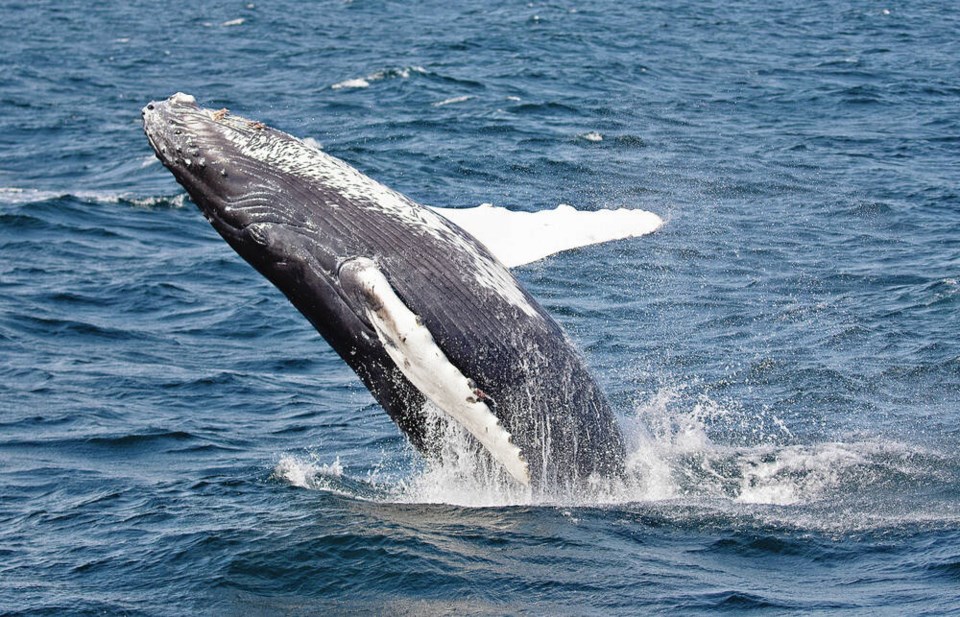There’s a baby boom in the Salish Sea’s humpback whale population.
Naturalists aboard whale-watching vessels have reported 21 new calves this summer and fall — the largest nursery batch on record and nearly double the previous high of 11 identified last year, said Mark Malleson of the Center for Whale Research in Washington.
He said late summer and autumn bring the peak of humpback activity, as the whales gorge on small fish and krill before traveling to warmer waters in Mexico, Central America and Hawaii to give birth and breed, then returning in late spring.
An adult humpback can eat about 900 kilograms a day, straining huge volumes of ocean water through their baleen plates, which act like a sieve.
“It has been a banner year for female humpbacks coming into the Salish Sea with new calves,” said Wendi Robinson, a naturalist with Puget Sound Express based in Port Townsend, Washington. “Calves only travel with their mothers for a year or so and then they’re on their own. Once they’re familiar with our waters, they will often return year after year to feed.”
The baby boom is being credited to an abundance of food, and the growing population of adult humpbacks.
Humpbacks are rebounding from near extinction. Populations were reduced worldwide by as much as 95% until a final moratorium on harvesting the species for meat and oil was introduced in 1985 by the International Whaling Commission.
Humpbacks have been protected in Canada since 1966, but a report by Ocean Watch said before that, at least 5,600 humpbacks were harvested from whaling stations along the B.C. coast starting in 1908, decimating the population.
The Salish Sea is one of the last historical areas that the humpbacks have “re-occupied” since the whaling days, said the report.
Ocean Watch said the inland waters of the Strait of Georgia extending south to Puget Sound is likely where “a small and possibly resident population of humpbacks was extirpated by 1909.”
The Committee on the Status of Endangered Wildlife in Canada lists the humpback’s current status as “special concern,” elevated from “threatened” status as the population rebounds.
The most recent population estimate for the North Pacific humpback whale ranging the B.C. and Alaska coasts was 18,302 individuals, recovering at a rate of 4.9 to 6.8 percent annually. Despite this increase, scientists believe current numbers are still below pre-whaling population estimates.
Research conducted between 2004 and 2006 indicated that about 2,145 whales (not including first-year calves) were present from spring to fall in B.C. waters. But a minimum of 4,000 animals would have been present off the west coast of Vancouver Island in 1905, a federal report said.
Humpbacks in the North Pacific continue to face several threats, including noise disturbance, habitat degradation in breeding grounds like Mexico, ship strikes and entanglement in fishing gear or debris.
But their numbers are increasing.
Val Shore, a naturalist with Eagle Wing Tours in Victoria, said a humpback known as Split Fluke and her newest calf, a female, delighted onlookers near the U.S-Canada border south of Victoria this week.
“The calf started things off with a few tail slaps … mom then joined in on it,” said Shore. Tail-slapping is a form of communication among the whales.
Split Fluke was born in 2006 and has been matched through photographs to Mexican breeding grounds in winter. This year’s calf, not yet named, is Split Fluke’s third, and represents a third generation of Salish Sea humpback whales.
In March, Sam Murphy, a naturalist for Anacortes-based Island Adventures Whale Watching, was doing seasonal work in Hawaii when she spotted a humpback whale with a calf in tow.
Murphy was able to identify the whale as Dreamer, a 10-year old humpback that has been photographed in recent years feeding near Victoria and the southern Gulf Islands during the summer.
Dreamer and her new baby were spotted in the Strait of Georgia this week and “we’re thrilled she’s back,” said Erin Gless, executive director of the Pacific Whale Watch Association.



